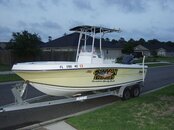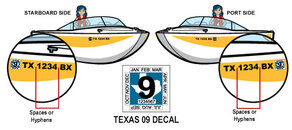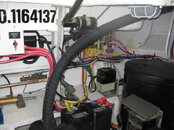I don't see any Florida registration numbers on the pics of the Scuba Shack Get Wet. Doesn't that mean it must be a documented vessel, or operating illegally with no reg/doc? I was under the impression all vessels had to be either state-registered, or USCG documented. The vessel status is confusing...
Every vessel, documented or not, must have FL numbers if they operate in the waters of the State of Florida. It's the law. Now, I don't post my FL numbers because I have the name of the vessel on each bow in 6" letters, along with the stern in 12" letters, along with the hailing port on the stern in 2" letters in accordance with USCG regulations. If I had a international ticket, I would have to put my IMO numbers on each side and on the roof in 12" numbers. If I ONLY had FL numbers, they would have to be in 2" letters/numbers on the bow. Regardless of the status of my FL numbers, I have to place my FL registration sticker on the port wheelhouse window right where I have my Apple Computer sticker. I don't. Vessels under 5 tons (like my dingy) are titled by the state. Vessels over 5 tons that are not documented are also titled.
There are many confusions in this thread. I'll try to start explaining them, although it has nothing to do with either of the "Get Wet's".
A vessel under 5 tons gross may not be documented. Documentation is like a title to a car. It follows the vessel forever until it is no longer documented. If there is a loan on the vessel, it is listed on the documentation certificate. Documentation is renewed every year, and any changes to the documentation must be approved by the first preferred ships mortgage holder. If I wish to change my vessel from commercial to recreational, the first preferred ship's mortgage holder must authorize it. A privately owned vessel, regardless of size, does not need to be documented, unless the owner wants to, or wants to take out a loan. No commercial vessels are undocumented. The documentation number must be permanently embossed in one of a few places. One of those places may be the crash bulkhead (required on a passenger vessel), on the engineroom bulkhead, or on the transom. Both of the "Get Wet's" would have been documented at one time.
Tonnage. Tonnage falls into 3 categories. First is displacement tonnage, which is only important if a vessel has a stability letter. Displacement tonnage is not noted anywhere. It's what the vessel actually weighs, or the amount of water it displaces. Displacement tonnage means nothing except to a travel lift operator and the marine architect. There are no regulatory drivers for displacement tonnage, and no one really knows what theirs is when you get into big boats. The second is net tonnage, which is also a worthless number. Each documentation certificate has the net tonnage of the vessel listed. It's the most a vessel could ever possibly displace with a full load of fuel, water, cargo, passengers, cars, etc. It is purely a calculated number based on the shape of the hull and means nothing to anyone. Gross tonnage is what drives regulations. When I said 5 tons above, it means 5 gross tons. Gross tonnage is a derived number based on 1869 rules for how many bales of cotton a vessel can carry. Really. Many spaces are exempt from the rules, and there are a bunch of tricks for exempting spaces from tonnage. Gross tonnage means everything to the Captain and the USCG, and it isn't even a real number. There are likely less than 100 folks in the USA that can calculate gross tonnage, and maybe 10 that can do it well enough to issue a tonnage certificate. The rules are onerous, complicated, and make no sense to anyone. I've seen 300 foot supply or anchor handlers in the Gulf that are 99 ton vessels. The Spree is a 99 ton vessel. We just squeaked in last time we were measured. Further, divide gross tonnage into registered tonnage (USA only) and International tonnage (ITC, or International Tonnage Convention). Spree has a dual tonnage certificate, because Registered tonnage isn't honored anywhere except the USA. So, the Spree is 99 GRT (Gross Registered Tons) and 141 GT-ITC (Gross Tons, International Tonnage Convention), or more commonly, just GT. A vessel below 100 GRT is allowed to be operated by a captain with a 100 ton license, does not need to meet any fire wall requirements, does not need an engineroom firefighting CO2 system, and is grandfathered forever for those requirements. There are lots of other gotchas, but those are the biggies.
Now, the difference between inspected and non-inspected. Inspected means you get the USCG to come and have a gander at your boat every year, every time you make a change to the configuration, and every 2 years you get to haul out and he can take a peek at the hull from the outside, including running gear and welds and through hulls etc. If you are on an international route, that changes to every year. Nothing is off limits to the inspector. A captain or owner who is trying to be proactive will find out what this years trouble spots are and prepare that part for inspection before the inspector ever shows up. This years critical push on aluminum boats with fresh water tanks integral to the hull is pitting in the fresh water tanks. There are a rash of aluminum boats getting their water tanks replaced right now because of pitting in those tanks. Last year it was corrosion under the battery boxes. Next year it may be electrical distribution panels. A vessel of over 100 tons may carry up to 12 passengers uninspected. It's an old holdover from the fruit ships that ran from New Orleans to Central America. They carried 12 passengers in relative luxury, but were mainly fruit carriers. There are at least 2 liveaboard dive vessels in Florida that operate under this exemption. One makes coastwise voyages (goes port to port within the USA), the other sails only internationally to the Bahamas. Vessels under 100 Gross Tons are limited to 6 passengers on a coastwise route or international route. I know of one liveaboard in this class in Florida. If you carry more than 6 passnegers and your vessel is under 100 tons, you're gonna have regular visits from the Coast Guard. We pay for this privilege, it isn't free. You may drop your COI (Certificate of Inspection) at any time, but if you ever want it back, you will have to bring the vessel up to standards as they are today.












